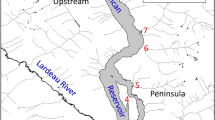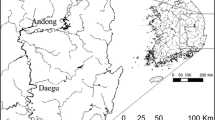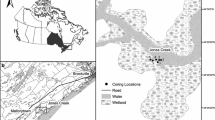Abstract
This study investigated the distribution and determinants of marsh vegetation along the major distributary channel system of southern Africa’s largest wetland, the Okavango Delta, using a large, inter-disciplinary data set. Eight communities were recognized, dominated respectively by Pennisetum glaucocladum, Phragmites mauritianus, Cyperus papyrus, Cyperus papyrus/Miscanthus junceus, Miscanthus junceus, Imperata cylindrica, Pycreus nitidus and a mixed bog community. The Pennisetum glaucocladum community is situated in the Panhandle (a narrow valley reach at the head of the fan) on elevated scroll bars that are flooded seasonally for short periods (days to weeks). The Phragmites mauritianus community occurs largely in the Panhandle where channel margins have high clay contents and where soils are seasonally flooded for moderate periods (months). Fires are widespread in the Panhandle, but both Pennisetum glaucocladum and Phragmites mauritianus are stoloniferous, and meristems occur below the soil surface and are protected from fire. In contrast, the rhizomatous sedge C. papyrus dominates in situations where meristems are permanently submerged, and therefore protected from fire, such as areas of open channel water where current velocities are sufficiently low to enable the extension of C. papyrus into the channel. This situation exists where channel avulsion has recently taken place or where discharge is reduced by water loss from the channel by overspill. The semi-floating habit of C. papyrus in the channel fringe results in high hydraulic conductivities, which promotes water loss from channels and leads to sediment deposition within channels. Miscanthus junceus occurs in areas where the nutrient status of water is low, seasonal changes in water level are small, and the average water level is approximately constant over decadal time scales. It occurs some distance from the channel on the upper reaches of the Delta and progressively closer to the channel downstream such that it is the dominant channel fringe species in the distal reaches. This pattern, where a community occurs progressively closer to the channel downstream is similar for communities dominated by Imperata cylindrica and Pycreus nitidus suggesting that environmental gradients (probably nutrient supply) perpendicular to the channel axis are steep and that they are mirrored by long-range environmental gradients downstream. An analysis of hydraulic characteristics of this distributary river system illustrates that channel width varies most with variation in discharge, while channel depth and current velocity are relatively constant over the range of discharges in the study area. Since channel width is primarily a consequence of vegetation processes in the channel margin, especially the growth of the giant sedge C. papyrus it is clear that channel hydraulics are affected largely by vegetation.
Similar content being viewed by others
Literature cited
Anderson, C. M. and M. Treshow. 1980. A review of environmental and genetic factors that affect height in Spartina alterniflora Loisel. Estuaries 3:168–176.
Arnold, T. H. and B. C. de Wet. 1993. Plants of southern Africa: names and distribution. Memoirs of the Botanical Survey of South Africa No. 62, National Botanical Institute, Pretoria, South Africa.
Breen, C. M., K. H. Rogers, and P. J. Ashton. 1988. Vegetation processes in swamps and flooded plains. p. 223–248. In J. J. Symoens and H. Lieth (eds.) Handbook of Vegetation Science, Volume 15. Junk, The Hague, The Netherlands.
Cronberg, G., A. Gieske, E. Martins, J. Prince Nenqu, and I. M. Stenstrom. 1995. Hydrobiological studies of the Okavango Delta and the Kwando/Linyanti/Chobe River, Botswana. I. Surface water quality analysis. Botswana Notes and Records 27:151–226.
Dincer, T., L. G. Hutton, and B. Khupe. 1987. A simple mathematical model of a complex hydrological system: Okavango swamp, Botswana. Journal of Hydrology 93:41–65.
Dye, P. J., R. E. Lee, and P. E. Reavell. 1976. Plant succession on spoil dumps along the Boro River, Okavango Delta, Botswana. Tropical Ecology 17:9–15.
Ellery, K., W. N. Ellery, K. H. Rogers, and B. H. Walker. 1990a. Formation, colonisation and fate of floating sudds in the Maunachira River System of the Okavango Delta, Botswana. Aquatic Botany 38:315–329.
Ellery, K., W. N. Ellery, K. H. Rogers, and B. H. Walker. 1991. Water Depth and biotic insulation: major determinants of back-swamp community composition. Wetlands Ecology and Management 1:149–162.
Ellery, W. N. 1988. Channel blockage and abandonment in the north-eastern Okavango Delta: the role of Cyperus papyrus L. MSc. Thesis. University of the Witwatersrand, Johannesburg, South Africa.
Ellery, W. N., K. Ellery, T. S. McCarthy, B. Cairncross, and R. Oelofse. 1989. A peat fire in the Okavango Delta, Botswana, and its importance as an ecosystem process. African Journal of Ecology 27:7–21.
Ellery, W. N., K. Ellery, K. H. Rogers, and T. S. McCarthy. 1995. The role of Cyperus papyrus L. in channel blockage and abandonment in the north-eastern Okavango Delta, Botswana. African Journal of Ecology 33:25–49.
Ellery, W. N., K. Ellery, K. H. Rogers, T. S. McCarthy, and B. H. Walker. 1990b. Vegetation of channels of the north-eastern Okavango Delta, Botswana. African Journal of Ecology 28:276–290.
Ellery, W. N., K. Ellery, K. H. Rogers, T. S. McCarthy, and B. H. Walker. 1993. Vegetation, hydrology and sedimentation processes as determinants of channel form and dynamics in the north-eastern Okavango Delta, Botswana. African Journal of Ecology 31:10–25.
Ellery, W. N. and T. S. McCarthy. 1998. Environmental change over two decades since dredging and excavation of the lower Boro River, Okavango Delta, Botswana. Journal of Biogeography 25:361–378.
Ellery, W. N., T. S. McCarthy, and J. M. Dangerfield. 2000. Floristic diversity in the Okavango delta, Botswana as an endogenous product of biological activity. p. 195–226. In B. Gopal, W. J. Junk, and J. A. Davis (eds.) Biodiversity in Wetlands: Assessment, Function and Conservation, Volume 1. Backhuys Publishers, Leiden, The Netherlands.
Garstang, M., W. N. Ellery, T. S. McCarthy, M. C. Scholes, R. J. Scholes, R. J. Swap, and P. D. Tyson. 1998. The contribution of aerosol- and water-borne nutrients to the functioning of the Okavango Delta ecosystem, Botswana. South African Journal of Science 94:223–229.
Gaudet, J. J. 1977. Uptake, accumulation and loss of nutrients by papyrus in tropical swamps. Ecology 58:415–422.
Gaudet, J. J. and F. M. Muthuri. 1981. Nutrient relationships in shallow water in an African lake, Lake Naivasha. Oecologia 49:109–118.
Gieske, A. 1996. Modelling surface outflow from the Okavango Delta. Botswana Notes and Records 28:165–192.
Hill, M. O. 1979. TWINSPAN—A FORTRAN program for arranging multivariate data in an ordered two-way table by classification of the individuals and attributes. Cornell University, Ithaca, NY, USA.
Leopold, L. B. and T. Maddock. 1953. The hydraulic geometry of stream channels and some physiographic implications. United States Geological Survey, Washington, DC, USA. Geological Survey Professional Paper 252.
Lubke, R. A., G. L. Raynham, and P. E. Reavell. 1981. Reassessment of plant succession on spoil heaps along the Boro River, Okavango Delta, Botswana. South African Journal of Science 77:21–23.
Lubke, R. A., P. E. Reavell, and P. J. Dye. 1984. The effects of dredging on the macrophytic vegetation of the Boro River, Okavango Delta, Botswana. Biological Conservation 30:211–236.
McCarthy, T. S., M. Barry, A. Bloem, W. N. Ellery, H. Heister, C. Merry, H. Ruther, and H. Sternberg. 1997. The gradient of the Okavango fan, Botswana, and its sedimentological and tectonic implications. Journal of African Earth Science 24:65–78.
McCarthy, T. S., A. Bloem, and P. A. Larkin. 1998. Observations on the hydrology and geohydrology of the Okavango Delta. South African Journal of Geology 101:101–117.
McCarthy, T. S. and W. N. Ellery. 1997. The fluvial dynamics of the Maunachira Channel system, northeastern Okavango Swamps, Botswana. Water SA 23:115–125.
McCarthy, T. S., W. N. Ellery, K. H. Rogers, B. Cairncross, and K. Ellery. 1986. The roles of sedimentation and plant growth in changing flow patterns in the Okavango Delta, Botswana. South African Journal of Science 82:579–584.
McCarthy, T. S., W. N. Ellery, and I. G. Stanistreet. 1992. Avulsion mechanisms on the Okavango fan, Botswana: the control of a fluvial system by vegetation. Sedimentology 39:779–795.
McCarthy, T. S., W. N. Ellery, and I. G. Stanistreet. 1993a. Lakes of the north eastern region of the Okavango Swamps, Botswana. Zeitschrift fur Geomorphologie N.F. 37:273–294.
McCarthy, T. S., N. J. Franey, W. N. Ellery, and K. Ellery. 1993b. The use of SPOT imagery in the study of environmental processes of the Okavango Delta, Botswana. South Africa Journal of Science 89:432–436.
McCarthy, T. S., J. R. McIver, B. Cairncross, W. N. Ellery, and K. Ellery. 1989. The inorganic chemistry of peat from the Maunachira channel-swamp system, Okavango Delta, Botswana. Geochemica Cosmochimica Acta 53:1077–1089.
McCarthy, T. S., K. H. Rogers, I. G. Stanistreet, W. N. Ellery, B. Cairncross, K. Ellery, and T. S. A. Grobicki. 1988. Features of channel margins in the Okavango Delta. Palaeocology of Africa 19:3–14.
McCarthy, T. S., I. G. Stanistreet, and B. Cairncross. 1991. The sedimentary dynamics of active fluvial channels on the Okavango Fan, Botswana. Sedimentology 38:471–487.
Mitsch, W. J. and J. G. Gosselink. 1993 Wetlands, second edition. Van Nostrand Rheinhold, New York, NY, USA.
Rzoska, J. Descent to the Sudan Plains. p. 197–214. In J. Rzoska (ed.) The Nile, Biology of an Ancient River. Junk, The Hague, The Netherlands.
Sawula, G. and E. Martens. 1991. Major ion chemistry of the lower Boro River, Okavango Delta, Botswana. Freshwater Biology 26:481–493.
Smith, N. D., T. S. McCarthy, W. N. Ellery, C. L. Merry, and H. Ruther. 1997. Avulsion and anastomosis in the Panhandle region of the Okavango Fan, Botswana. Geomorphology 20:49–65.
Smith, P. A. 1976. An outline of the vegetation of the Okavango drainage system. p. 93–112. In Botswana Society, Symposium on the Okavango Delta and its future utilization. Gaborone, Botswana.
Stanistreet, I. G. and T. S. McCarthy. 1993. The Okavango Fan and the classification of subaerial fan systems. Sedimentary Geology 85:115–133.
Ter Braak, C. J. F. and P. Smilauer. 1988. Canoco reference manual and user’s guide to Canoco for Windows. Software for Canonical Community Ordination (version 4). Microcomputer Power, Ithaca, NY, USA.
Thompson, K. 1976. The primary productivity of African Wetlands, with particular reference to the Okavango Delta. p. 67–79. In Botswana Society, Symposium on the Okavango Delta and its future utilization. Gaborone, Botswana.
Thompson, K. and A. C. Hamilton. 1983. Peatlands and swamps of the African Continent. p. 331–373. In A. J. P. Gore (ed.) Mires, Swamp, Bog, Fen, and Moor. B. Regional Studies. Elsevier Scientific Publishing Company, Amsterdam, The Netherlands.
Thompson, K., P. R. Shewry, and H. W. Woolhouse. 1979. Papyrus development in the Upemba Basin, Zaire: studies of population structure in Cyperus papyrus stands. Botanical Journal of the Linnaean Society 78:299–316.
Wilson, B. H. and T. Dincer. 1976. An introduction to the hydrology and hydrography of the Okavango Delta. p. 33–48. In Botswana Society, Symposium on the Okavango Delta and its future utilization. Gaborone, Botswana.
Author information
Authors and Affiliations
Corresponding author
Rights and permissions
About this article
Cite this article
Ellery, W.N., McCarthy, T.S. & Smith, N.D. Vegetation, hydrology, and sedimentation patterns on the major distributary system of the Okavango fan, Botswana. Wetlands 23, 357–375 (2003). https://doi.org/10.1672/11-20
Received:
Accepted:
Issue Date:
DOI: https://doi.org/10.1672/11-20




